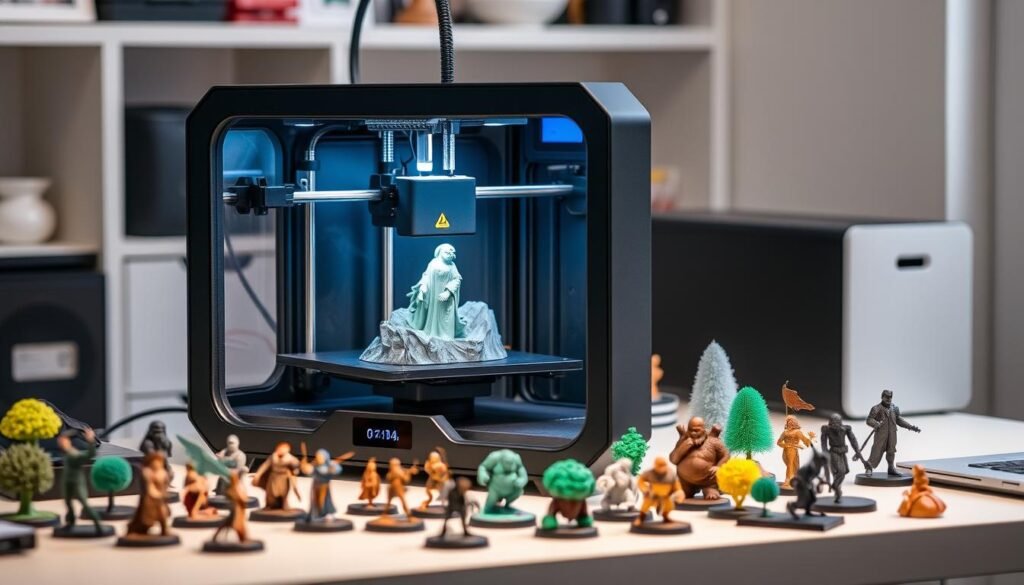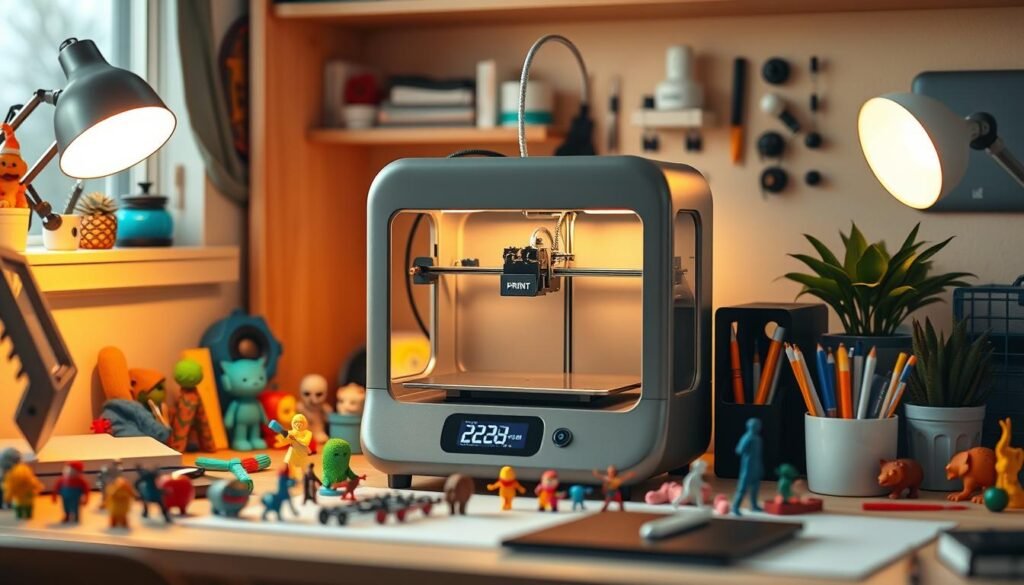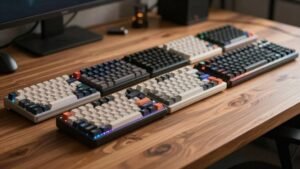Are you ready to make your tabletop gaming characters come to life? The world of 3D printing for miniatures is booming. It gives gamers more control over their hobby than ever before. But, with so many choices, how do you pick the best 3D printer for miniatures?
We’ve explored the world of 3D printing to help you. We found options for every budget, from under $150 to top-of-the-line machines. We’ve got you covered.

Our research shows the best 3D printers for miniatures have amazing details. They have XY resolutions from 18 to 52 microns. Print volumes range from 130 x 73 x 165 mm to 228 x 128 x 245 mm. These details make your figurines and terrain pieces look incredible.
Whether you’re new to 3D printing or looking to upgrade, we’ve got you covered. We looked at print quality, speed, build plate size, and community support. We analyzed everything to help you choose wisely.
Join us as we dive into the exciting world of 3D printing for miniatures. See how this technology is changing tabletop gaming forever.
Introduction to 3D Printing for Miniatures
3D printing miniatures has changed tabletop gaming and wargaming terrain. It lets us make unique and detailed figurines. Let’s look at how 3D printing has grown in gaming and its benefits.
The Rise of 3D Printing in Gaming
The gaming world has welcomed 3D printing. It changes how we make miniatures. Now, gamers and hobbyists can make their ideas real. From fantasy creatures to intricate wargaming terrain, 3D printing opens new doors.
Benefits of 3D Printing Miniatures
3D printing miniatures has many benefits:
- Customization: Make designs just how you like them
- Cost-effectiveness: Save money compared to buying miniatures
- Rapid prototyping: Test and improve designs fast
- Accessibility: Print rare or hard-to-find miniatures
What to Look for in a 3D Printer for Miniatures
When picking a 3D printer for miniatures, think about these:
| Feature | Importance | Recommended Specs |
|---|---|---|
| Print Resolution | High | 25-35 microns for good quality, 15-22 microns for top quality |
| Build Plate Size | Medium | Depends on the size of your miniatures, usually 5″ x 3″ or bigger |
| Print Speed | Medium | Varies by printer type, faster is better |
| Reliability | High | Choose printers with good reviews and support |
SLA 3D printing is great for miniatures because it shows details well. But, your choice depends on what you need and your budget.
Knowing these points will help you pick the right 3D printer. Whether you’re making detailed figurines or big wargaming terrain, you’ll find the perfect one.
Understanding 3D Printer Technology for Miniatures
3D printing has changed how we make tiny figurines. Resin 3D printers are especially good for detailed models. They use liquid resin that hardens layer by layer, creating very fine details.
Resin 3D printers are special because of their high resolution. They can print at heights as low as 50 microns. This means your miniatures will have sharper details and smoother surfaces.
- LCD screens: These provide faster curing times and improved detail.
- DLP projectors: Known for their longer-lasting light sources.
When picking a printer for miniatures, look at XY resolution and Pixels Per Inch (PPI). These affect your print’s quality. For example, Bambu Labs printers with a 0.2mm nozzle can print miniatures with great detail.
Resin printers are great for details but cost more. You’ll need to buy resin tanks, isopropyl alcohol, UV lamps, and safety gear. But many people find the quality of resin-printed miniatures worth the extra cost.
Resin vs. FDM Printers for Miniature Creation
Choosing between resin and FDM printers affects your 3D printed miniatures. Let’s explore the main differences to help you decide.
Advantages of Resin Printers
Resin printers are great for detailed miniatures. They can print layers as thin as 10 microns. This results in smooth surfaces and detailed features.
When to Consider FDM Printers
FDM printers are best for bigger prints and simpler designs. They’re great for making terrain and larger accessories. FDM prints are faster and can handle bigger sizes than resin.
Print Quality Comparison
Resin and FDM printers differ in quality. Resin prints are smoother and more detailed. FDM prints might have layer lines, but resin looks polished right away.
| Feature | Resin Printers | FDM Printers |
|---|---|---|
| Layer Height | 10-50 microns | 50-400 microns |
| Surface Finish | Smooth | Visible layer lines |
| Detail Level | High | Moderate |
| Print Speed | Slower | Faster |
| Post-Processing | Cleaning and curing | Sanding and painting |
Your choice depends on your needs. For detailed miniatures, resin is best. For bigger prints or speed, FDM is better. Both are important in miniature creation. Just like picking the right drill bits for metal projects, the right 3D printer is crucial.
Key Features to Consider in a 3D Printer for Miniatures
When picking a 3D printer for miniatures, some features are very important. Print resolution is key. For detailed work, look for printers that can print layers as thin as 0.1mm. Some, like the Wanhao Duplicator D6, can even print layers as thin as 0.05mm. This is great for small details like facial features.
Build volume is also crucial. Small printers are good for one-off miniatures. But bigger printers let you print more at once. Here’s a look at some popular sizes:
| Printer Model | Build Volume (mm) | Price (USD) |
|---|---|---|
| Anycubic Photon Mono X | 192 x 120 x 245 | 549 |
| Prusa Mini+ | 180 x 180 x 180 | 429 |
| Elegoo Mars 2 Pro | 129 x 80 x 160 | 145 |
| Creality Ender 3 V2 | 220 x 220 x 250 | 279 |
Nozzle size affects how detailed your prints can be. Most mini printers use a 0.4mm nozzle. But some have smaller nozzles, like 0.2mm, for even more detail. Also, the materials you can print with can make your miniatures look better.
Finally, think about how fast and precise the printer is. Resin printers, like the Anycubic Photon Mono X, print fast. FDM printers are better for printing lots of miniatures quickly.
Best 3D Printer for Miniatures: Top Picks
We’ve tested many top 3d printers to find the best for making stunning miniatures. Our research focused on key factors like resolution, build volume, and print quality. Let’s look at three models that stand out for making miniatures.
Elegoo Mars 3 Pro
The Elegoo Mars 3 Pro is a game-changer for those who love miniatures. It has a 35-micron resolution and a 6.6-inch mono LCD screen. This makes it perfect for both hobbyists and beginners.
Anycubic Photon Mono X
If you need more space, the Anycubic Photon Mono X is great. It has a bigger build volume and 50-micron resolution. It’s perfect for printing many miniatures at once, especially for gamers.
Phrozen Sonic Mini 8K
The Phrozen Sonic Mini 8K is top for ultra-fine details. It has an amazing 22-micron resolution. While it’s more expensive, it’s worth it for those who want the best quality.
| Printer Model | Resolution | Build Volume | Best For |
|---|---|---|---|
| Elegoo Mars 3 Pro | 35 microns | Medium | Beginners, Hobbyists |
| Anycubic Photon Mono X | 50 microns | Large | Batch Printing |
| Phrozen Sonic Mini 8K | 22 microns | Small | Ultra-detailed Prints |
Each printer has its own benefits for making miniatures. Whether you’re starting or upgrading, one of these top 3d printers will meet your needs. It will make your miniature gaming better.
Budget-Friendly Options for Beginners
Starting with 3D printing can seem tough, especially when thinking about cost. That’s why we’ve found some cheap 3d printers for beginners. These resin printers are great and won’t cost a lot.
The Elegoo Mars 2 Pro is a great pick for miniatures fans. It costs just $149 and prints high-quality miniatures. It’s easy to use, perfect for beginners.
The Anycubic Photon Mono 2 is another good choice. It’s $149 on Amazon. It’s a good mix of quality and price, great for new resin users.

If you want FDM printing, the Creality Ender 3 V3 SE is a great deal at $199. It’s seen as the best budget FDM printer. It’s reliable and easy to use for beginners.
Let’s compare these budget-friendly options:
| Printer | Price | Type | Best For |
|---|---|---|---|
| Elegoo Mars 2 Pro | $149 | Resin | Miniatures |
| Anycubic Photon Mono 2 | $149 | Resin | General Use |
| Creality Ender 3 V3 SE | $199 | FDM | Larger Objects |
These affordable 3d printers show that quality doesn’t have to be expensive. Whether you like miniatures or bigger projects, there’s a beginner-friendly option for you and your budget.
High-End 3D Printers for Professional-Quality Miniatures
Looking for the best results? Professional 3d printers are your answer. They offer unmatched precision and quality. These top-notch resin printers take miniature creation to new heights.
Formlabs Form 3
The Formlabs Form 3 is a top choice among professional 3d printers. It uses Low Force Stereolithography to achieve a 25-micron XY resolution. Its build volume of 14.5 × 14.5 × 18.5 cm is great for detailed miniatures or small batches.
Prusa SL1S SPEED
Prusa’s SL1S SPEED is perfect for those who want high resolution and fast printing. It’s great for hobbyists who want to improve their work. It balances professional quality with easy-to-use features.
Peopoly Phenom L
The Peopoly Phenom L is ideal for large format 3d printing. It has a big build volume for making many miniatures or large terrain pieces. This printer is top-notch for creating professional-grade models at any size.
| Printer | Resolution | Build Volume | Key Feature |
|---|---|---|---|
| Formlabs Form 3 | 25 microns | 14.5 × 14.5 × 18.5 cm | Low Force Stereolithography |
| Prusa SL1S SPEED | 50 microns | 12.7 × 8 × 15 cm | Rapid printing speed |
| Peopoly Phenom L | 72 microns | 34.5 × 19.5 × 40 cm | Large build volume |
These professional 3d printers have cool features like automatic resin dispensing and strong software integration. They cost more, but the quality and detail of your miniatures will be worth it.
Maintenance and Care of Your 3D Printer
Keeping your 3D printer in good shape is key for great prints. We’ll show you how to do it. Regular care makes your printer work better and last longer.

For resin printers, clean the build plate and vat after each print. Change the FEP film often to keep prints looking good. Always wear gloves and a mask when handling resin. It’s also important to dispose of resin safely.
Leveling the print bed is very important. It helps your prints stick right and look as they should. Do this often, especially if your prints are not coming out right.
- Clean workspace regularly
- Update firmware
- Calibrate printer settings
- Check and tighten belts and screws
Staying on top of maintenance means better prints and less trouble later. By following these steps, your 3D printer will keep making miniatures for you without a hitch.
| Maintenance Task | Frequency | Importance |
|---|---|---|
| Clean build plate | After each print | High |
| Replace FEP film | Every 20-30 prints | Medium |
| Level print bed | Monthly | High |
| Update firmware | Quarterly | Medium |
Software and Slicing for Miniature 3D Printing
Creating perfect miniatures needs the right 3d printing software and slicing settings. We’ll look at popular options and techniques for great results.
Popular Slicing Software
Many slicing programs are great for miniatures. PrusaSlicer is free and makes high-quality prints. IdeaMaker is good at making supports, saving time later. Ultimaker Cura has over 400 settings for precise work.
For resin printing, Chitubox offers free and premium versions for $169 a year. KISSlicer lets you try basic features before paying more.
| Software | Key Feature | Price |
|---|---|---|
| PrusaSlicer | High-quality output | Free |
| IdeaMaker | Advanced support generation | Free |
| Ultimaker Cura | 400+ customizable settings | Free |
| Chitubox | Resin-specific slicing | Free / $169 per year |
Optimizing Print Settings for Miniatures
Adjusting slicing settings is key for miniatures. Change layer height, exposure times, and support for the best results. Use anti-aliasing and image blur to hide layer lines, making details clearer.
Finding and Preparing 3D Models
Find miniature 3d models on Thingiverse, MyMiniFactory, and Cults3D. When getting models ready, make sure they’re oriented right, add supports, and hollow big pieces to save resin. These steps help your prints come out well.
- Orient models for optimal printing
- Add necessary supports
- Hollow larger pieces to conserve material
- Check for any mesh errors before printing
Legal Considerations and Copyright Issues in 3D Printing Miniatures
3D printing miniatures is exciting for gamers and hobbyists. But, we must understand the legal side. Knowing about 3d printing copyright, legal 3d models, and miniature licensing helps avoid legal trouble.
The Berne Convention, from 1887, protects creative works for 50 years after the author dies. In the EU and US, this is 70 years. We must follow these copyright laws when printing miniatures.
Many game companies have rules for 3D printed miniatures for personal use. Always check these rules before printing. Buying licensed models from independent 3D artists is a good way to follow the law and enjoy the hobby.
- Check copyright status before printing
- Purchase licensed models from reputable sources
- Respect game companies’ policies on 3D printing
- Consider Creative Commons licenses for sharing designs
For custom designs, make sure you have the right to use any parts. If unsure, get legal advice to avoid copyright issues. Remember, 3D printing can lead to piracy worries because it can copy protected items.
| Year | Event |
|---|---|
| 2017 | Disney asked Thingiverse to remove Star Wars files |
| 2022 | Honda asked Prusa to remove files with its name |
| 2018-2022 | Thingiverse users grew from 2.3 million to 6.2 million |
As the 3D printing world grows, so does the need for clear rules on licensing miniatures. By knowing the law and respecting intellectual property, we can enjoy 3D printing miniatures. This way, we also support the creative world.
Conclusion
The 3D printing hobby has changed how we make miniatures, especially for tabletop games. We looked at many printers, from cheap to expensive ones. Each one meets different needs and skill levels.
The Anycubic Photon M3 prints fast, at 3.93 in/h. The ELEGOO Neptune 4 Max has a huge build area. These are just a few examples of amazing tech out there.
Resin printers, like the Anycubic Photon Mono M5, are great for small details. It has a 10.1-inch monochrome LCD screen. Filament printers, like the AnkerMake M5C, are good for bigger projects. They can make things as detailed as resin prints, but often need less work after printing.
Choosing between resin and filament printers depends on what you need. Resin printers, like the Elegoo Mars 2 Pro Mono, make very precise miniatures. Filament printers are cheaper and offer more material choices. No matter what you pick, 3D printing makes creating miniatures more fun and creative for tabletop gamers.






